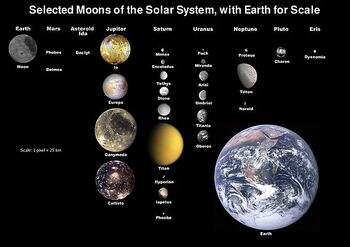There are currently 173 known natural satellites (or moons) in the Solar System, excluding the moons of dwarf planets. The largest natural satellite in the Solar System is Jupiter's moon, Ganymede. Ganymede and Saturn's largest moon, Titan, are bigger than the planet Mercury. Earth's Moon is the fifth largest moon in the Solar System after Ganymede and Triton (listed above), Callisto and Io. Titan often appears to be on because of its dense atmosphere which makes it appear to be just gas, ad the surface of the moon is not visible. Only 7 of the 173 known moons in the colar system are more than 2,000 kilometers in diameter.
List of natural satellites in the Solar System by size[]
This is a list of the moons which have a radius of 550 kilomters or more in the Solar System of planets and dwarf planets.
| Satellite of Earth | Satellite of Jupiter |
| Satellite of Saturn | Satellite of Uranus |
| Satellite of Neptune | Satellite of Pluto |
| Name | Radius (km) | Atlernative name | Discovery year | Discovered by |
|---|---|---|---|---|
| Ganymede | 2,634.1 | Jupiter III | 1610 | Galileo Galilei |
| Titan | 2,575.5 | Saturn VI | 1655 | Christiaan Huygens |
| Callisto | 2,408.4 | Jupiter IV | 1610 | Galileo Galilei |
| Io | 1,818.1 | Jupiter I | 1610 | Galileo Galilei |
| Moon | 1,737.1 | Earth I | ---- | ---- |
| Europa | 1,560.7 | Jupiter II | 1610 | Galileo Galilei |
| Triton | 1,353.4 | Neptune I | 1846 | William Lassell |
| Titania | 788.9 | Uranus III | 1787 | William Herschel |
| Rhea | 764.5 | Saturn V | 1672 | Giovanni D. Cassini |
| Oberon | 761.4 | Uranus IV | 1787 | William Herschel |
| Iapetus | 734.5 | Saturn VIII | 1671 | Giovanni D. Cassini |
| Charon | 603.6 | Pluto I | 1978 | James W. Christy |
| Umbriel | 584.7 | Uranus II | 1851 | William Lassell |
| Ariel | 578.9 | Uranus I | 1851 | William Lassell |
| Dione | 562.5 | Saturn IV | 1684 | Giovanni D. Cassini |
